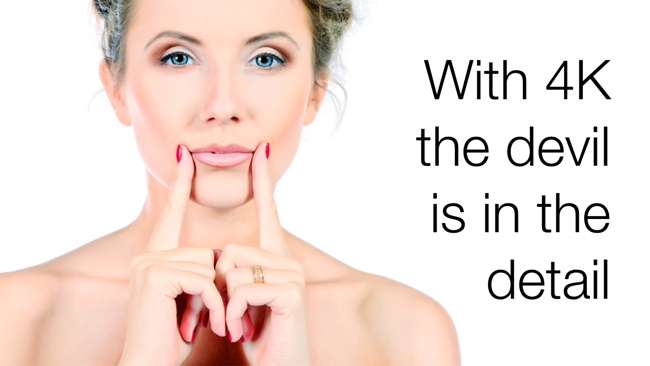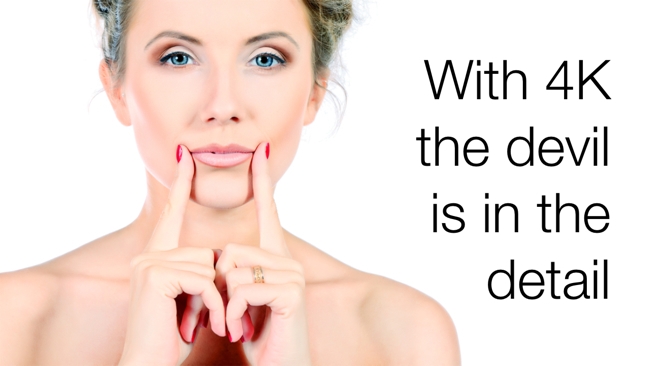
 4K devil is in the detail
4K devil is in the detail
Our industry is in a full-on rush to 4K. More pixels means more detail, which can sometimes be a bad thing. Here, we investigate ways to reign-in excess detail for more flattering close-ups
A couple years ago, I received a frantic call from a producer. He was putting together a low budget shoot for a fundraising video and his shooter abruptly jumped ship two days before they were set to start. There wasn’t much pay available, but just enough that I didn’t feel like I would be working for free, plus a small per diem and lodging. The producer was in a bind, and I had the space in my schedule, so I found myself on the next plane to Eugene, Oregon.
It was a three day project. The first two days went swimmingly, which was a bit of a relief. I was shooting on a Panasonic AF100, which came out only a few weeks before. It was my first experience with that camera, but to a certain extent, ‘a camera is a camera’, so I fell back on that belief and trusted that, as long as I was careful, I could get through any difficulties. Thankfully, it was all easy-breezy and the production went like clockwork.
On day three, we had a scene with an older actress, who I will name ‘Betty’. Betty had a booming voice and was not shy in using it. She took one look at the AF100 and asked, “Is that an HD camera?”
“Yes,” I responded. When I’m operating camera, I prefer to keep conversations with actors to a polite minimum.
Betty threw her head back and scoffed, “Oh dear. I hate HD! Everyone looks positively dreadful in it. Do we need to see everyone’s pores?”
I reassured her that this wasn’t always the case, but I didn’t have time to get into a rangy debate. Taken at face value, Betty isn’t that far off in her assertion. More pixels generally means more detail, but there are ways to selectively reduce detail of your image. As we near mass adoption of 4K displays, these techniques will only grow in importance.
Soft lighting
When it comes to making a flattering close-up (or portrait), soft lighting is your friend, especially for female subjects. In short, a light is ‘soft’ when it’s large and close to your subject. It’s all about relative size. The softest possible light comes from a completely overcast day, because the light is so big it’s literally everywhere, producing extremely gradual fall-off to shadow. In lieu of perpetually overcast days, use big, soft-ish lights, preferably cool lights like large Kino banks, then break-up the light with a filter. Filtering of this type makes your light source less directional, and increases secondary bounces to your subject. For cool lights, you don’t even need to use standard film gels. In a pinch, a quick trip to a local fabric store will yield a shimmery, translucent sheet that can easily be fixed onto a gobo arm, to place in front of your Kinos or LEDs. If you only have hot lights, use film-grade diffusion and keep an eye on it, because it will burn. Or you can bounce the light off an actual bounce board, a flex-fill, a wall or ceiling. Soft lighting doesn’t really reduce detail, but leads to a more sculpted image and flattering portraiture, which can provide a good base for the following recommendations.
Short-to-mid telephoto lenses
There’s a reason short-to-mid length telephoto lenses, 85-135mm on full frame 35mm, are traditionally referred to as ‘portrait’ lenses. First off, telephoto lenses have a subtle slimming effect on subjects, and flattens features like noses and chins. When compared to wide lenses, this effect is immediately noticeable. If you’ve ever tried to shoot a close-up with a 35mm lens, you know what I mean. Unless you have a very specific reason to shoot close-ups in wide, don’t. The other beneficial characteristic of telephoto lenses is that they tend to be a little less sharp than normal or wide lenses, especially at lower f-stops. You would think that this lack of resolving power would be a hindrance, and for certain subjects, like nature, it may be. For close-ups of human subjects, however, it could be just what you need, and may eliminate the need for any lens filtration.
Lower F-stops
For just about every lens ever made, the higher f-stops are much sharper than the lower f-stops. If you really want to get technical, there’s usually a degradation from a lens’ sweet spot (typically around f/8) to it’s highest aperture, because the aperture becomes so small that it causes light to refract. But this is nothing compared to the difference between f/8 and, say, f/1.4. In designing your shots, you can use this knowledge to your advantage, by either controlling the light on set so that you’re shooting your closeups at around f/2.8 (plus or minus a stop, depending on your specific lens), or use neutral density filters or a quality ND fader to attain proper exposure at the desired f-stop.
Medium close-ups
I once got into a spat with a producer who loved big close-ups. In the end, I dropped it and did what he wanted me to do, but I’m constantly amazed that people want part of an actor’s head to fill the entire screen. If all video players were tiny and embedded, it would be more understandable. Composition gives way to the more practical consideration of being able to see the actor. But, personally, unless it’s grainy YouTube fare, I watch video either full screen on my computer or on my television. For my taste, I don’t want big close-ups unless they are really earned and motivated by what’s happening in the story, and even then, sparingly. What does this have to do with reducing detail? Well, if you compose your close-ups as medium CUs instead of close or extreme CUs, you make your coverage more appropriate for bigger screens. And you can avoid some of the detail pitfalls in the planning stage, by making your subject take up less real estate on those screens.
Make-up
This seems like a no-brainer, and for those that work on big budget projects, the thought that someone would shoot something without a makeup artist must seem like lunacy. But it happens, all the time. It especially happens when the ‘producer’ (re: person closest to the money) doesn’t normally work in film production, but is tasked with overseeing a project. This person will spend money on everything, but ‘makeup’ will be an afterthought, as in “Hmm, maybe I should have hired a makeup artist.” If you find yourself working for such an individual, it doesn’t hurt to ask if there will be a makeup artist on set, and if that person is actually qualified, or someone ‘pitching-in’. Having such knowledge before you get on set may help you make other decisions to compensate, such as which softening filters to request/bring.
Softening filter
These lens filters come in a variety of different names, such as Pro-Mist, Black Pro-Mist, Pro-Frost, Soft FX, Diffusion FX, and many more. Although they differ, primarily in the amount/character of the halation, they pretty much all do the same thing: they reduce small details, like pimples and ruddiness, while letting larger details, like eyes, pass through. As a rule of thumb, when 1/8 is the lowest level of filtering, use 1/4 for wider shots and 1/8 for close-ups. When 1/2 is the lowest value, use 1 in wide and 1/2 in close. Using these figures as a guide, you can still achieve a relatively unfiltered look with subtle benefits of lens filtering. I like using Tiffen 1/8 Pro-Mist for a nice, clean look, and 1/8 Black Pro-Mist when I want a dingier look. I’ve heard great things about Tiffen Gold Diffusion FX 1/2, but I’ve never used it myself, so maybe one of you can chime in and let us know.
Digital filters and Post
If you’ve taken some combination of the above steps, you probably won’t need to do much in post to reduce detail. Otherwise, your editor can always ‘fix it in post’ (cringe). All of the Tiffen products mentioned above are available as a suite of post effects, named DFX (currently in Version 3) and available as a standalone product or as a plugin to Final Cut, Avid, Premiere and After Effects. This software mimics the entire line of Tiffen filters and strengths, with live previewing. Of course, you may use your NLE’s pre-packaged effects to reduce the sharpness of your image. Sometimes it helps to reduce saturation and contrast a little. But if you’re relying on controlling detail in post, you may want to take your video into a compositor and use animated masks/mattes to gain even more control over your image. It just depends on how far you and your production wants to take it.
Consider my abbreviated list as a jumping off point for further conversation. What techniques do you use to artistically reduce detail? Do you smear vaseline on Saran Wrap and rubber band it to your matte box? Do you only cast actors with flawless skin? Is there some amazing post utility that you’re dying to share? Comments welcome!
Tags: Production


Comments